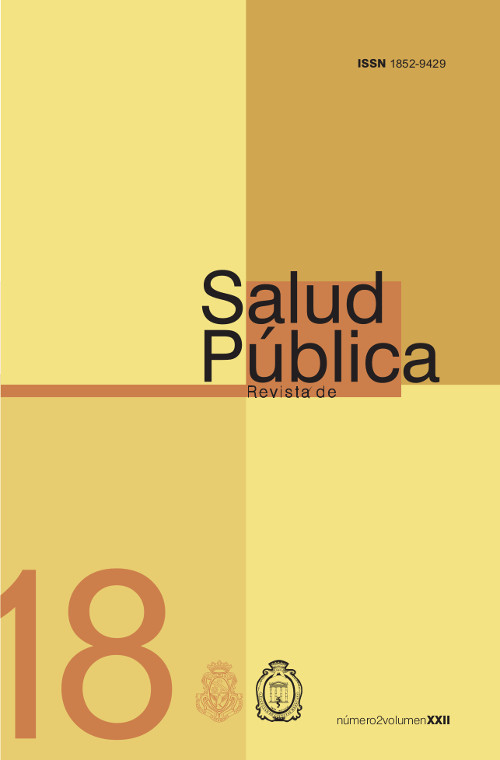MONITORING OF VOC’S IN THE AIR OF THE CITY OF CORDOBA, ARGENTINA.
DOI:
https://doi.org/10.31052/1853.1180.v22.n2.20787Keywords:
Air Pollution, Environment, Environmental Monitoring, ArgentinaAbstract
On April 22, 1997, the city of Cordoba opens the Municipal Environmental Observatory. Up to the year 2001, the city had an automatic monitoring net of atmospheric pollution generating continuous measurements of contaminants criteria (NO2, SO2, CO, O3 and PM10). Other non conventional atmospheric contaminants such as Volatile Organic Compounds (VOC’s) were also measured but sporadically and without consistency. This work starts from the need to have measurements of environment concentration of VOC’s to assess the health risk and take decisions regarding public and private policies, since they require information about levels of population exposure to contaminants, number of people exposed, length of exposition, and the knowledge of quantitative relationships between exposition and effects on health. In this short communication we inform about the results of a year of continuous monitoring of VOC’s in the micro center of the city of Cordoba.
Downloads
References
Arriaga-Colina, J. L., West, J. J., Sosa, G., Escalona, S. S., Ordúñez, R. M. and Cervantes, A. D. M. Measurements of VOC´s in Mexico City (1992-2001) and evaluation of VOC´s and CO in the Emissions Inventory. Atmospheric Environment. 2004; 38:2523-2533.
California Air Resources Board (CARB), 1989. https://www.arb.ca.gov/msprog/aftermkt/omstar/omstar.pdf.
World Health Organization (OMS) Regional Office for Europe, Copenhagen. Air Quality Guidelines for Europe. WHO Regional Publications, European Series, No. 91, Second Edition, ISBN 92 890 1358 3, 2000.
Directiva Europea de Calidad del Aire 2000/69 /CE del Parlamento Europeo y del Consejo, de 16 de noviembre de 2000, sobre los valores límite para el Benceno y el monóxido de carbono en el aire ambiente.
Resolución 105 del Ministerio de Agua, Ambiente y Servicios Públicos. Boletín Oficial de la Provincia de Córdoba, año CIV - Tomo DCXXXI - Nº 128 Córdoba, (R.A.), martes 4 de julio de 2017. http://boletinoficial.cba.gov.ar/wp-content/4p96humuzp/2017/07/1_Secc_04072017.pdf.
Duan J., Tan J., Yang L., Wu S., Hao J. S. Concentration, sources and
ozone formation potential of volatile organic compounds (COVs) during
ozone episode in Beijing. Atmos. Res. 2008; 88:25-35.
Primo Y. E. (1996), Química orgánica básica y aplicada: de la molécula
a la industria. Tomo 1. Universidad Politécnica de Valencia. Reverte.
Barcelona, España. pp 261-268.
Koss G y Tessaraux R (1999), “Hydrocarbons”. En: Hans Marquardt,
Siegfried G. Schäfer, Roger Mc Clellan, Frank Welsch (Eds) Toxicology.
Chapter 25. Academic Press. EUA. pp 603-613.
Swoboda-Colberg. Chemical contamination of the environment, sources, types and fate of synthetic organic chemicals. En, Youn, L.Y.; Cerniglia, C.E. (Eds.), Microbial transformation and degradation of toxic organic chemicals. Pág. 27-74. Wiley-Liss, New York, 1995.
Hartley W. R. and Englande A. J. Jr. «Health risk assessment of the
migration of unleaded gasoline: a model for petroleum productos». Water
Science and Technology. 1992; 25:65-72.
Buckley T. J., Payne-Sturges D., Kim S. R. and Weaver V. COV
Exposures in an Industry-Impacted Community. NUATRC Research
Report, Number 4. Baltimore:. Department of Environmental Health
Sciences. Johns Hopkins Bloomberg School of Public Health. 2005.
User’s Guide ppbRAE 3000. http://www.raesystems.com/sites/default/files/content/resources/Manual_ppbRAE3000_RevE.pdf. 2014.
Campos J. M., 2012. Aplicación de Redes Neuronales Artificiales para la Predicción de MP10 y O3. Premio mejor tesis (ISBN 9789872889104.
Mugica V. A., Vega E. R. y Ruiz M. E. .Determination of hydrocarbons
emission non-methane profiles in parkings of the city of México.
Memorias. IV. Congreso Interamericano sobre el medio ambiente. Tomo
, 1997.
Mugica V. A, Ruiz M.E., Watson J. y Chow J. Volatile Organic
Compounds in México City Atmosphere: Levels and Sources
Apportionment. Atmósfera, (16):15–27. 2003.Antonia Baeza Caracena,
Enrique González Ferradas, Agustín Miñana Aznar «El benceno en el aire
de la ciudad de Murcia proyecto life-macbeth» Editores: Universidad de
Murcia, Año de publicación: 2001, País: España, Idioma: español, ISBN:
-8371-242-3
Baeza Caracena A., González Ferradas E., Miñana Aznar A., 2001.
«El Benceno en el aire de la ciudad de Murcia proyecto life-macbeth».
Editores: Universidad de Murcia, País: España, Idioma: español, ISBN:
-8371-242-3.
Sbarato R. D. y Rubio M. 2017, Modelación matemática de la distribución de COV´s en la ciudad de Córdoba, Argentina. Comunicación Breve. Revista de la Escuela de Salud Pública, Facultad de Ciencias Médicas, Universidad Nacional de Córdoba. Enviado a Publicar.
Sbarato R. D. y Rubio M. 2017, Estimación de COV´s emitidos por
fuentes fijas y móviles en el aire de la ciudad de Córdoba, Argentina.
Comunicación Breve. Revista de la Escuela de Salud Pública, Facultad
de Ciencias Médicas, Universidad Nacional de Córdoba. Aceptado para
publicar.
Downloads
Published
How to Cite
Issue
Section
License
Copyright (c) 2018 Escuela de Salud Pública y Ambiente. Facultad de Ciencias Médicas. Universidad Nacional de Córdoba

This work is licensed under a Creative Commons Attribution-NonCommercial 4.0 International License.
Authors who publish with this journal agree to the following terms:
- Authors retain copyright and grant the journal right of first publication with the work simultaneously licensed under a Creative Commons Attribution License which allows the work to be copied, distributed, exhibited and interpreted as long as it is not done for commercial purposes.
- Authors are able to enter into separate, additional contractual arrangements for the non-exclusive distribution of the journal's published version of the work (e.g., post it to an institutional repository or publish it in a book), with an acknowledgement of its initial publication in this journal.
- Authors are permitted and encouraged to post their work online (e.g., in institutional repositories or on their website) after the publication process. (See The Effect of Open Access). (See The Effect of Open Access).



